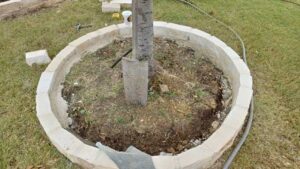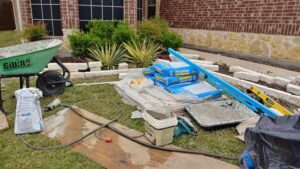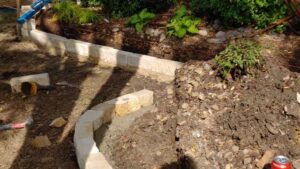
solvida
Building a Stone Retaining Wall (10 Tips)
Stone retaining walls and stone flower bed borders provide a functional way to retain soil and mulch in a planting bed, keep neighboring grass from taking over your garden and lend an elegant look to your landscaping.
If you’re thinking of building a stone retaining wall yourself or hiring a stone mason to do the work for you, we hope our 10 tips to building a stone retaining wall help with your project.

How to build a dry stack retaining wall?
If you need to retain an area of your landscaping which reaches over 4 inches in height, your retaining wall will likely include multiple rows of masonry stone work. As long as the stone is flat on the top and bottom, you can install multiple rows by dry-stacking the stones to creating a retaining wall.
Start by digging a trench 2-4 inches below the soil line. Make sure the trench bottom is level to ensure the growing rows of stonework will be level as well.
Next, install stonework right next to each other in the trench. If you are using natural stones with rough side edges, plan to use a masonry saw or chisel to create smooth edges that fit together.
Finally, to build a dry stack retaining wall or install stone landscape edging that is stable, make sure to alternate how the stone edges line up. Meaning that the middle of each stone on the above row is installed just above where the 2 stones on the row just below meet. In other words, make sure to not line up stone edges in rows that touch.

Best way to build a stone garden wall with mortar?
Using mortar to build your stone garden wall around a flower bed creates a more finished and stable wall.
Below are a few tips to help ensure you know the best way to build a stone garden wall with mortar.
Tip 1: Install a level concrete footing with rebar.
Tip 2: Mix your mortar per instructions and make sure you don’t add too much water to the mixture.
Tip 3: Keep your mortar joints under 1” in width.
Tip 4: Offset stones in a shingle like manner.
Tip 5: Create weeping holes throughout the garden wall to ensure water can easily pass.
Building a wall with mortar is a messy job, so if you’re landscape design plans include laying new sod grass, make sure and do that after the stone wall.

How to build a raised bed wall with blocks?
If you are building your raised bed wall with retaining blocks as opposed to natural stone, you will likely be doing a dry stack installation.
Start installation by digging a trench 2-4 inches in depth for your first row and take the necessary time to ensure that the trench is level.
Alternate the installation of each row so you’re retaining block edges don’t line up to the row below it.
Secure each row to the blocks beneath it using glue for masonry work for more structural support.

How to build a retaining wall on sloped ground?
When building a retaining wall on sloped ground, you will want to take time upfront to account for various wall levels in your landscape design plans. Identify low and high terrain points before installing any part of your wall.
Start by trenching at the lowest point of your wall and extend it as far as you can. If you’re not installing a level concrete footing, make sure your trench has a level surface by compacting the soil or installing decomposed granite or sand.
Install your retaining wall stones in the trench until the upper stone on your lowest row has reached ground level, begin the next trench, making sure it matches the height of the first neighboring stonework.
Repeat this process until you have completed the retaining wall.

How to build a circular stone retaining wall?
Creating a circular stone retaining wall, sometimes called a tree ring, requires smaller stone pieces and more cuts.
You may find that some manufactured retaining wall blocks are precut into angled pieces requiring little to no cutting.
If using a natural stone, you will need a masonry saw or chisel to create the cuts and angles needed to create a circular installation.
In order to build a circular stone retaining wall, simply follow instructions from above in this article called “How to build a raised bed wall with blocks”

Materials needed to build a chopped stone wall?
Building materials needed to create a chopped stone wall include the chopped stone, decomposed granite or sand and masonry glue when dry stacking the stone.
If you are building a mortared chopped stone wall remove the decomposed granite or sand and masonry glue and replace with concrete, rebar and mortar to your building materials list.

Best stone materials to build a flower bed wall?
If you prefer to use natural stone, the best material to use is chopped stone when building a flower bed wall.
Chopped stone is made from a variety of natural stone such as limestone and sandstone and is cut from a mill into rectangular pieces. Chopped stone can be found in a variety of colors and heights. Some stones such as Austin chopped stone are very soft and easy to cut with a chisel while others such as Oklahoma chopped stone require a masonry saw for cutting.
Installing chopped stone around landscaping beds is a popular idea for landscaped areas without grass and an easy hardscaping upgrade to increase your DFW home value.

How deep footing for a stone garden wall?
If your stone garden wall will be a simple 1-2 row installation, you should trench at least a 2 inch footing.
However, if your wall will include mortared stonework or extend over 2 rows in height, your stone garden wall footing should be 3-4 inches deep.

What is the easiest retaining wall to build?
The easiest retaining wall to build would be a dry-stacked block installation using pre-cut concrete blocks.

How to build a retaining wall with drainage?
To allow for water to drain and prevent damage from pressure behind a wall you’ll want to build your retaining wall with drainage by installing “weeping holes”.
Weeping holes can be drilled directly into the mortar gaps, the stonework itself or created by cutting ½”-1” pvc pipe pieces and installing them within the mortar joints between the stones. These “weeping holes” should be installed throughout the stonework at and below the soil line every 4 feet on average.